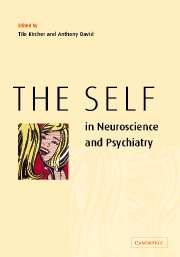Book contents
- Frontmatter
- Contents
- List of contributors
- Introduction: the self and neuroscience
- Part I Conceptual background
- Part II Cognitive and neurosciences
- 5 The multiplicity of consciousness and the emergence of the self
- 6 Asynchrony, implicational meaning and the experience of self in schizophrenia
- 7 Self-awareness, social intelligence and schizophrenia
- 8 The neural correlates of self-awareness and self-recognition
- 9 Autonoetic consciousness
- 10 The neural nature of the core SELF: implications for understanding schizophrenia
- Part III Disturbances of the self: the case of schizophrenia
- 11 Self and schizophrenia: a phenomenological perspective
- 12 Self-disturbance in schizophrenia: hyperreflexivity and diminished self-affection
- 13 The self-experience of schizophrenics
- 14 The paranoid self
- 15 Schizophrenia and the narrative self
- 16 Self-narrative in schizophrenia
- 17 Schizophrenia as disturbance of the self-construct
- 18 Action recognition in normal and schizophrenic subjects
- 19 Disorders of self-monitoring and the symptoms of schizophrenia
- 20 Hearing voices or hearing the self in disguise? Revealing the neural correlates of auditory hallucinations in schizophrenia
- 21 The cognitive neuroscience of agency in schizophrenia
- 22 Self-consciousness: an integrative approach from philosophy, psychopathology and the neurosciences
- References
17 - Schizophrenia as disturbance of the self-construct
from Part III - Disturbances of the self: the case of schizophrenia
Published online by Cambridge University Press: 18 December 2009
- Frontmatter
- Contents
- List of contributors
- Introduction: the self and neuroscience
- Part I Conceptual background
- Part II Cognitive and neurosciences
- 5 The multiplicity of consciousness and the emergence of the self
- 6 Asynchrony, implicational meaning and the experience of self in schizophrenia
- 7 Self-awareness, social intelligence and schizophrenia
- 8 The neural correlates of self-awareness and self-recognition
- 9 Autonoetic consciousness
- 10 The neural nature of the core SELF: implications for understanding schizophrenia
- Part III Disturbances of the self: the case of schizophrenia
- 11 Self and schizophrenia: a phenomenological perspective
- 12 Self-disturbance in schizophrenia: hyperreflexivity and diminished self-affection
- 13 The self-experience of schizophrenics
- 14 The paranoid self
- 15 Schizophrenia and the narrative self
- 16 Self-narrative in schizophrenia
- 17 Schizophrenia as disturbance of the self-construct
- 18 Action recognition in normal and schizophrenic subjects
- 19 Disorders of self-monitoring and the symptoms of schizophrenia
- 20 Hearing voices or hearing the self in disguise? Revealing the neural correlates of auditory hallucinations in schizophrenia
- 21 The cognitive neuroscience of agency in schizophrenia
- 22 Self-consciousness: an integrative approach from philosophy, psychopathology and the neurosciences
- References
Summary
Abstract
Human self-consciousness can be defined as the capacity to metarepresent one's own mental states, such as perceptions, judgements, beliefs or desires. It is thus closely related to the so-called theory of mind capacity, which requires the ability to model the mental states of others. Other constitutive features of human self-consciousness comprise the experiences of ownership or agency, of egocentric perspectivity and of long-term unity of beliefs and attitudes. These features are assumed to be neurobiologically implemented as episodically active complex neural activation patterns that can be mapped to the brain given adequate operationalizations of these constitutive features. This bundle of constitutive features is called self-construct to distinguish clearly this empirically motivated operationalized approach from classical philosophical concepts. In the pathophysiology of schizophrenia, it is suggested that clinical subsyndromes like cognitive disorganization and derealization syndromes reflect disorders of partial features of self-consciousness. In this chapter the issue of first-person perspective as opposed to third-person perspective is addressed in more detail. With special regard to the psychopathological symptom of hallucinations, the relevance of the self-construct for the pathophysiology of schizophrenia is discussed.
Self-consciousness and potential empirical indicators
Self-consciousness is a central theme in classical philosophy and contemporary philosophy of mind and has also recently become one of the focuses of cognitive neurosciences. If empirical indicators for self-consciousness or at least for some of its constitutive features can be identified, then operationalization and subsequent mapping to neural structures become possible.
- Type
- Chapter
- Information
- The Self in Neuroscience and Psychiatry , pp. 359 - 379Publisher: Cambridge University PressPrint publication year: 2003
References
- 1
- Cited by



